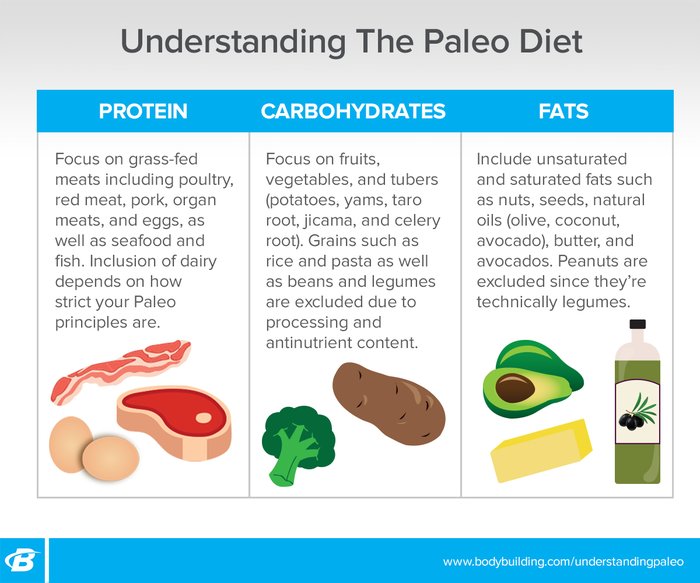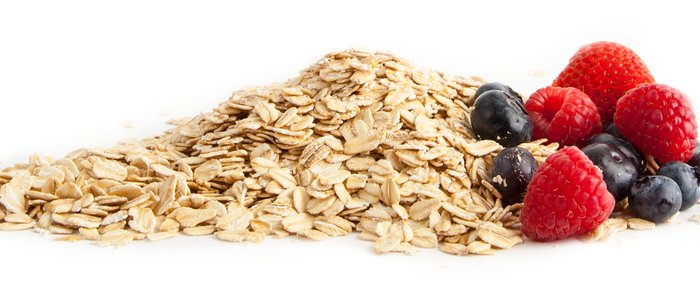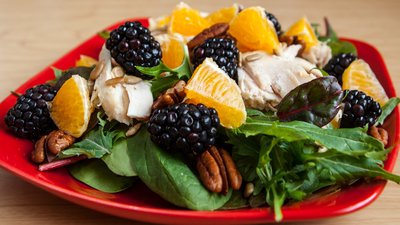Anyone looking to maximize their gym performance would be foolish not to make lean proteins, fibrous carbohydrates, healthy fats, and ample fruits and vegetables the basis of their diet. Get rid of refined, processed foods in favor of these wholesome choices, and you have a combination that's right for any performance goal.
It just so happens that the paleo diet is founded on these very principles, which is why many high-level athletes follow this approach. Carb subtleties aside, the basic paleo-diet framework is sound and tough to argue against. But a grueling 90-minute lift, compilation of two-a-day training, or a prolonged endurance session will require more than an abundance of fruits, vegetables, and tubers to get the job done.
Here are two major changes to prime your Paleo approach for maximal performance!
Understanding the Paleo Diet
The paleo diet attempts to mimic the diet our omnivorous hunter-gatherer ancestors followed during the Paleolithic era. It's based on eating naturally occurring real foods that have been subjected to little to no processing. Paleo is characterized by:
- Moderate protein intake
- Moderate-to-high fat intake
- Low-to-moderate carbohydrate intake
- Zero processed foods

Missing Link No. 1
With Paleo's emphasis on being grain- and bean-free, finding the right carbohydrate sources suddenly becomes a major challenge. Sure, you can eat ample fruits, vegetables, and tubers, but you may become full well before getting all the carbs you need to maximize performance and recovery. That's because fruits and vegetables are high in both water and fiber, both of which fill your stomach and slow your digestion. Try eating 100 grams of carbohydrates from veggies between your two daily training sessions and see how far you get.
Break the Carbohydrate Commandment
Strict Paleo means ingesting 50-150 grams of carbohydrates per day. If you were a sedentary person or just doing a light exercise program, that might be enough—especially if you were trying to lose weight. But for someone training as hard as you, it makes sense to bend the carbohydrate commandment. By including oats or rice on hard training days, you can ramp up the amount of fuel your body has on board to support high-intensity training and adequate recovery.
What to Choose
Stick with groats, steel-cut oats, rice, beans, and lentils (not the canned variety), all of which will be less processed than other carb sources.

Missing Link No. 2
Depending on who you ask, dairy may or may not be on the paleo guest list. The "dairy cow" as we know it today didn't roam the earth tens of thousands of years ago. And it's questionable whether anyone back then would have attempted to milk the wild, distant ancestors of the modern cow, which is why many paleo advocates abstain from any dairy-based food.
But the favorable nutritional profile of dairy can't go unnoticed, and as a hard-training athlete, you'd be foolish not to bend this paleo principle.
Dive Into Dairy
Although not crucial for performance success, dairy can absolutely bolster your muscle-building and fat-loss efforts, taking your performance up a notch. Dairy is an excellent source of high-quality protein, calcium, and vitamin D. All three of these nutrients profoundly influence performance, recovery and body composition—key areas of interest for any athlete.
Protein
Protein needs no introduction or long spiel about its wonderful fat-loss and muscle-building benefits. Protein directly instigates muscle building while promoting satiety. But milk-based protein has so many good properties that it warrants a full rundown of its many benefits.
Milk protein is unique, because it's a mixture of whey (fast-digesting) and casein (slow-digesting) proteins. Whey, in particular, is rich in the branched-chain amino acids (BCAAs), particularly leucine, the main instigator of muscle growth.[1] Both whey and milk protein have been shown to optimally stimulate muscle-building in the period after resistance training.[2,3] Whey protein supplementation has also been shown to spare muscle mass during a dieting phase.[4] There's no "whey" you can expect to maximize performance without including this protein in your daily diet.
Dairy also provides immune-bolstering proteins like beta-lactoglobulin, alpha-lactalbumin, and lactoferrin. Beta-lactoglobulin and alpha-lactalbumin play a role in enhancing the immune system.[5,6] Lactoferrin has also been shown to possess both antibacterial and antiviral properties.[7] After all, you can't train hard if you're at home in bed all the time!
Calcium
Calcium plays a role in bone formation and muscle contraction. What's more, meeting your daily calcium needs—particularly from dairy—has been shown to further drive weight loss (specifically body fat), and protect muscle mass while dieting.
An Obesity Research study divided participants into two groups, members of which consumed either a small (one serving per day) or large (three servings per day) amount of dairy for 24 weeks.[8] At the end of the time period, researchers found that the high-calcium group had greater fat loss, improved insulin sensitivity, and reduced blood pressure compared to the low-calcium group.
The second part of the study placed each group into a 500-calorie deficit. While both groups lost significant amounts of weight and body fat, the high-calcium group lost nearly twice as much weight and body fat and retained more muscle mass compared to the low-calcium group.
For most types of training, sporting more muscle mass and less fat mass is sure to heighten performance. If you're calcium is lacking, you can expect little moo-vement in your gym numbers.

Vitamin D
Vitamin D deficiency is the number one nutrient deficiency in the United States. Since the primary source of vitamin D is the sun, any little bit that can be obtained from a food source is helpful.[9] It just so happens that milk is fortified with vitamin D. One cup provides you with 30 percent of the (albeit low) recommended daily amount.[10] Vitamin-D deficiency has a negative impact on strength, sleep quality, and injury risk, all of which impact your ability to perform well.[11]
What to Choose
If you're looking to keep some semblance of paleo with your dairy, opt for full-fat options, because these undergo less processing than the low-fat varieties.
Putting Paleo in Perspective
It's important to remember that the paleo diet isn't a rulebook that you need to live by, but rather a collection of ideas and guidelines to help enhance your health and well-being. To take your performance to the next level, you need to be willing to give your body the high-quality resources it needs to repair itself and grow. (For even more on those resources, read my guide to paleo snacks and supplements.) When following a paleo approach, be willing to make the necessary sacrifices to achieve your goals. They’ll be worth it!
References
- Norton, L. E., Layman, D. K., Bunpo, P., Anthony, T. G., Brana, D. V., & Garlick, P. J. (2009). The leucine content of a complete meal directs peak activation but not duration of skeletal muscle protein synthesis and mammalian target of rapamycin signaling in rats. The Journal of Nutrition, 139(6), 1103-1109.
- Tipton, K. D., Elliott, T. A., Cree, M. G., Aarsland, A. A., Sanford, A. P., & Wolfe, R. R. (2007). Stimulation of net muscle protein synthesis by whey protein ingestion before and after exercise. American Journal of Physiology-Endocrinology and Metabolism, 292(1), E71-E76.
- Wilkinson, S. B., Tarnopolsky, M. A., MacDonald, M. J., MacDonald, J. R., Armstrong, D., & Phillips, S. M. (2007). Consumption of fluid skim milk promotes greater muscle protein accretion after resistance exercise than does consumption of an isonitrogenous and isoenergetic soy-protein beverage. The American Journal of Clinical Nutrition, 85(4), 1031-1040.
- Frestedt, J. L., Zenk, J. L., Kuskowski, M. A., Ward, L. S., & Bastian, E. D. (2008). A whey-protein supplement increases fat loss and spares lean muscle in obese subjects: a randomized human clinical study. Nutrition & Metabolism, 5(1), 1.
- Sandstrom, O., Lonnerdal, B., Graverholt, G. & Hernell, O. (2008). Effects of alpha-lactalbumin–enriched formula containing different concentrations of glycomacropeptide on infant nutrition. American Journal of Clinical Nutrition, 87(4), 91-98.
- Hernandez-Ledesma, B., Recio, I. & Amigo, L. (2008). Beta-Lactoglobulin as source of bioactive peptides. Amino Acids, 35, 257-265.
- Tomita, M., Bellamy, W., Takase, M., Yamauchi, K., Wakabayashi, H. & Kawase, K. (1991). Potent antibacterial peptides generated by pepsin digestion of bovine lactoferrin. Journal of Dairy Sciences, 74(12), 4137-4142.
- Zemel, M. B., Richards, J., Milstead, A., & Campbell, P. (2005). Effects of Calcium and Dairy on Body Composition and Weight Loss in African‐American Adults. Obesity Research, 13(7), 1218-1225.
- Fulgoni, V. L., Keast, D. R., Bailey, R. L., & Dwyer, J. (2011). Foods, Fortificants, and Supplements: Where Do Americans Get Their Nutrients? Journal of Nutrition, 141(10), 1847-1854.
- U.S. Department of Agriculture, Agricultural Research Service. 2011. USDA National Nutrient Database for Standard Reference, Release 24. Nutrient Data Laboratory Home Page, http://www.ars.usda.gov/ba/bhnrc/ndl.
- Dahlquist, D. T., Dieter, B. P., & Koehle, M. S. (2015). Plausible ergogenic effects of vitamin D on athletic performance and recovery. Journal of the International Society of Sports Nutrition, 12(1), 1-12.

